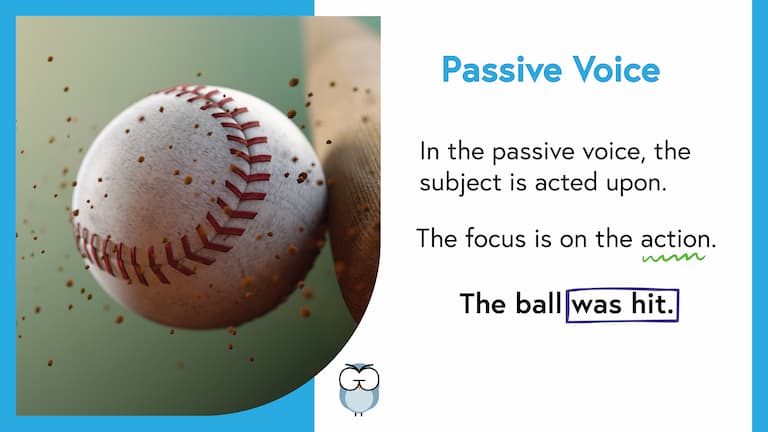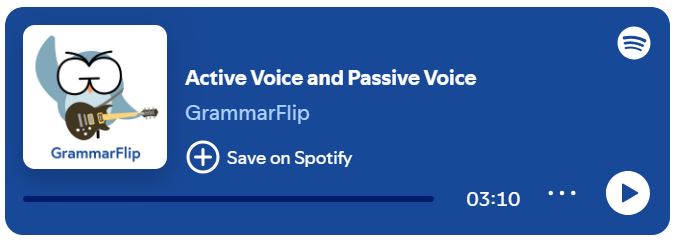What is Active Voice? What is Passive Voice?
In sentences using the active voice, the subject performs the action. In sentences using the passive voice, the subject is acted upon. Some examples of active voice and passive voice would be the following:
The police arrested the suspect late last night.
[Active: The subject “police” performs the action “arrested.”]
The suspect was arrested by police late last night.
[Passive: The subject “suspect” is being acted upon.]
The archaeologist found an ancient artifact.
[Active: The subject “archaeologist” performs the action “found.”]
An ancient artifact was found by the archaeologist.
[Passive: The subject “artifact” is being acted upon.]
Miriam folded the sheets and pillowcases.
[Active: The subject “Miriam” performs the action “folded.”]
The pillowcases were folded by Miriam.
[Passive: The subject “pillowcases” is being acted upon.]
Long-Form Video: Active Voice and Passive Voice
Long-form instructional video lessons allow students to engage with grammar concepts in more depth and detail.
This format provides students with a stronger foundation and a more comprehensive understanding of the active voice and passive voice.
Grammar-in-Context Video: Active Voice and Passive Voice
GrammarFlip’s grammar-in-context videos provide an additional layer of instruction, learning, and relatability.
Our unique and memorable video footage helps solidify the understanding of challenging grammar concepts.
Watch this video to better understand active voice and passive voice!
Short-Form Video: Active Voice and Passive Voice
Short-form videos are an excellent way to review grammar concepts. Our two-minute instructional videos help students review active voice and passive voice to further solidify their understanding.
Memorable Images: Active Voice and Passive Voice

The use of images to connect visual cues with concepts makes it simpler for students to grasp and remember key ideas. GrammarFlip’s memorable images create visual associations that make the active and passive voice more engaging and easier to retain.

Definition Cards: Active Voice and Passive Voice

Definition cards reinforce grammar concepts by providing clear and concise explanations that students can easily reference for quick review and better retention. GrammarFlip’s definintion cards help students review the concept of active voice and passive voice to further solidify their understanding.

Music: Active Voice and Passive Voice
Learn grammar concepts through music! The unique verses and catchy chorus in our “Active Voice and Passive Voice” song will help your students further understand the active and passive voice. Listen for yourself and see if you don’t walk away singing this song to yourself!
Listen to GrammarFlip Music via Spotify, Apple, or Amazon!
Music Videos: Active Voice and Passive Voice
Music videos make grammar concepts more engaging and memorable by combining rhythm, visuals, and repetition to reinforce learning. GrammarFlip’s music videos help students retain the concept of the active and passive voice more effectively while making the learning process fun and interactive.
Why You Should Use Active Voice and Passive Voice in Your Writing
It’s important to use both active voice and passive voice in your writing. Doing so adds complexity and variety, but there are times when focusing on one type of voice over the other is beneficial. Let’s take a look at some reasons to focus on one voice over the other.
Active Voice
Direction and Clarity: Using the active voice in sentences has the benefit of being more direct and clearer to your reader. There is more focus on the performer of the action in the sentence. For example:
Mikayla kicked the ball.
In this sentence which uses the active voice, attention is focused on Mikayla and her action of kicking the ball.
The active voice is especially important in persuasive writing and in narrative writing. If you’re trying to convince someone of something, highlighting the action or the subject can play a significant role. Similarly, if you’re telling a story, the active voice allows the reader to visualize or see the action more clearly than it would if you were using the passive voice.
Passive Voice
Formality and Objectivity: The passive voice is what writers should use when there is a need for objectivity and formality. In the passive voice, focus is placed more upon the verb and recipient of that action. Take a look at the following sentence:
The ball was kicked.
Notice how the focus is placed upon “ball” and “kicked,” and we aren’t even aware of who actually kicked the ball.
The passive voice is used quite often in formal and academic writing where being objective and neutral is important.
Download a Free Worksheet on Active Voice and Passive Voice!
Click the image below to download your free worksheet on active voice and passive voice!

Do your students understand the difference between active and passive voice?
Explore More GrammarFlip Lessons!
Parts of Speech lessons provide the building blocks of grammar. GrammarFlip covers these topics in detail to ensure a solid foundation is built. First time learners and students seeking to review the parts of speech can both benefit from the instructional videos and slide show reviews.
Parts of the Sentence lessons are critical for understanding how the parts of speech function in language construction. From the basic to the advanced, these lessons will cover a wide range of grammar topics that can be used in any grade level or classroom.
Mechanics and Usage lessons equip students with the necessary skills to communicate clearly to all audiences. With a focus on the application of these concepts in student writing, these lessons tie together both simple constructions of grammar as well as the more complex such that any age or skill level of student will benefit.



